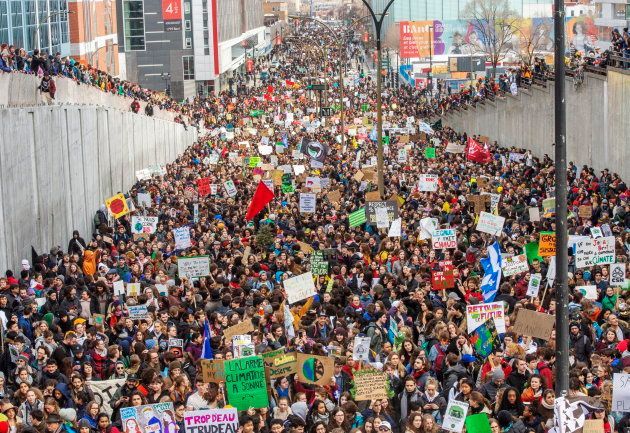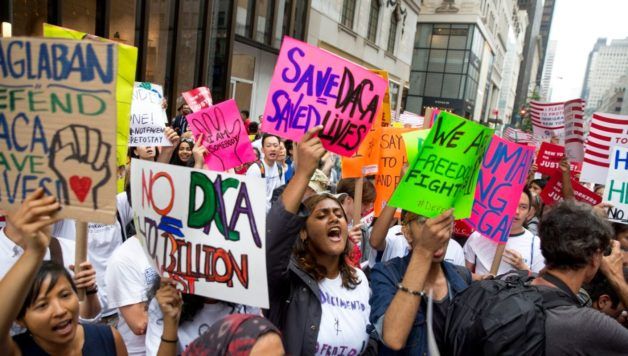
Among the world’s youth there is an ever-growing feeling that they have inherited a doomed planet. The youth strike for climate justice on May 24 saw protests in 1,880 cities in 133 countries with 1.5 million marching. March 15 was the biggest so far this year with 2,380 demos in over 135 countries and 1.8 million people were on the streets. In Montreal 150,000 protested with smaller demos all across Canada. It is not surprising that these students’ frustration and anxiety is finally boiling over; for decades governments of all political stripes have been sitting on their hands in the face of global ecological collapse.
Contrary to Trudeau’s international image, Canada is not a leader on the environment. It is the world’s fourth largest of exporter of crude oil and natural gas, and seventh largest exporter of coal. Trudeau hopes to continue Harper’s plans to boost exports, particularly of crude oil, bitumen and natural gas. The oil and gas sector already contribute 25% of Canada’s total CO2 emissions, the largest part coming from the tar sands.
There is clear evidence in Canada that climate change is growing: forest fires, melting ice in the Arctic and glaciers, floods and severe weather. The Liberals’ response was to buy a pipeline.
Canada, on average, is experiencing warming at twice the rate of the rest of the world according to a recent report commissioned by Environment and Climate Change Canada. Since 1948, in Northern Canada the annual average temperature has increased by 2.3oC. A 2019 UN report expects that Arctic winter temperatures will increase by 3oC to 5oC by 2050 compared to 1986-2005 levels. This would lead to widespread melting of permafrost, releasing more carbon dioxide and methane, both greenhouse gases, as well as significant sea-level rise due to melting glaciers and sea ice. In February 2018, the temperature at the north of Greenland reached 6oC, meanwhile it snowed in Rome. Sea-ice cover in the Arctic is thinning and contracting fast. This has weakened the jet stream winds, resulting in cold winter air flowing out of the Arctic, causing a deep freeze across much of North America as the polar vortex moved south.
It is likely that 80% of the glaciers in the Rockies will melt away over the next 50 years. These ice fields feed most of the major rivers of western Canada. The communities and farms along these rivers rely on these glaciers for year-round water.
Canada’s Environment Commissioner, Julie Gelfand, called government inaction “disturbing,” pointing to $1.6 billion per year of “inefficient” federal fossil fuel subsidies, and warning that Canada will not meet its 2030 greenhouse gas reduction targets.
The student activists are right to demand an urgent response to climate change. According to the Intergovernmental Panel on Climate Change, an United Nations scientific body, we have until 2030 to reduce our carbon emissions by half in order to avoid an “extinction level” catastrophe, yet 2018 marked the highest year in history for human-caused emissions.
The slogan “people over profits” is one of the most popular at the strikes. This is the heart of the matter: capitalist economies are entirely unequipped to handle this crisis. This is the great contradiction of our age. The capitalist ruling class would rather see their profits increase than prevent our species’ extinction. The 1% will largely be insulated from the consequences of their actions; it is the global working class who will bear the brunt of a potential ecological collapse.
However, these strikes demonstrate that all is not lost. What these radicalized youth understand is the power of collective action. While it can feel as though the 1% have a stranglehold on the economy and the wheels of government, it is fundamentally we, the workers, who move the world through our labour.
The rolling youth strikes mark a turning point in the fight against climate change, but they are not enough on their own. It is critical that workers, inspired by the youth, take action. Support is growing for the Earth Strike on September 27. Workers have the power to take decisive action against extinction.
The technology and knowledge to overcome climate change already exist. The barrier is the economic and political system that put profits of the few before the needs of humanity. The excuse of big business and their politicians is that we have to choose between jobs and the environment. Yet capitalism, for many, does not provide jobs and many of the jobs that exist are low-paid and insecure.
One million dollars invested in the oil and gas sector provides, on average, two jobs, while that same million invested in clean energy or energy efficiency provides fifteen. The $4.5 billion spent buying the Kinder Morgan pipeline could have provided 60,000 jobs. Rather than continuing to invest in damaging fossil fuels, Canada needs a national green jobs program, which would overhaul the energy sector and provide thousands of new, union jobs. Imagine if the NDP boldly campaigned on for a full and fair transition with guaranteed work for all.
The active involvement of workers and unions is indispensable to link the climate movement to the broader struggles of the working class and all those oppressed by capitalism. It will take a massive transformation from business-as-usual to address the impending ecological disaster. To fully deliver good union jobs and have a fair transition to a fossil fuel free economy we need international planning and cooperation. Both are impossible under capitalism.
Right now, youth are leading the way, because it is they, our children, who will suffer the most if climate change is not stopped. We must follow their inspirational example. We can secure a future for our children in which they not only have a planet to live on, but one that is worth living on.


